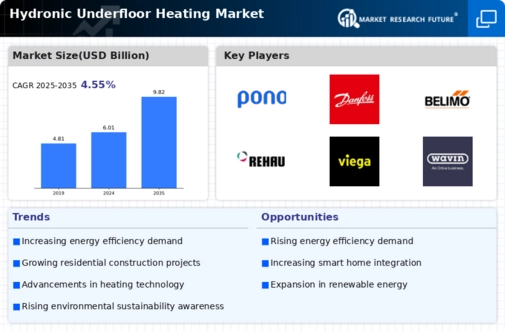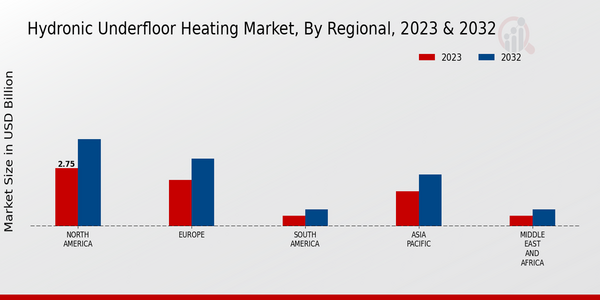Rising Construction Activities
The Global Hydronic Underfloor Heating Market Industry is significantly influenced by the surge in construction activities worldwide. As urbanization accelerates, there is a growing need for modern heating solutions in residential and commercial buildings. Hydronic underfloor heating systems are increasingly being integrated into new constructions due to their space-saving design and enhanced comfort levels. This trend is particularly evident in regions experiencing rapid population growth and infrastructure development. The demand for these systems is expected to rise in tandem with construction projects, thereby contributing to the overall market growth and expanding its footprint in the global arena.
Growing Demand for Energy Efficiency
The Global Hydronic Underfloor Heating Market Industry is witnessing a notable increase in demand for energy-efficient heating solutions. As energy costs continue to rise, consumers and businesses are increasingly seeking systems that provide optimal heating with minimal energy consumption. Hydronic underfloor heating systems, which utilize water to distribute heat evenly across a space, are recognized for their efficiency compared to traditional heating methods. This trend is reflected in the projected market value of 6.01 USD Billion in 2024, with expectations to reach 9.82 USD Billion by 2035, indicating a compound annual growth rate of 4.56% from 2025 to 2035.
Increased Awareness of Health Benefits
The Global Hydronic Underfloor Heating Market Industry benefits from a growing awareness of the health advantages associated with underfloor heating systems. Unlike traditional heating methods that can circulate dust and allergens, hydronic systems provide a more hygienic heating solution by minimizing air movement. This aspect is particularly appealing to families with allergies or respiratory issues. As consumers become more health-conscious, the preference for systems that promote better indoor air quality is likely to increase. This shift in consumer behavior may lead to a higher adoption rate of hydronic underfloor heating, further driving market growth.
Technological Advancements in Heating Systems
Technological innovations play a crucial role in the evolution of the Global Hydronic Underfloor Heating Market Industry. The integration of smart technology, such as programmable thermostats and IoT-enabled systems, enhances user control and efficiency. These advancements allow for precise temperature regulation, which can lead to significant energy savings. Furthermore, the development of more efficient heat exchangers and pumps contributes to the overall effectiveness of hydronic systems. As consumers become more aware of these technologies, the market is likely to see increased adoption, further driving growth and expanding the potential customer base.
Environmental Regulations and Sustainability Initiatives
The Global Hydronic Underfloor Heating Market Industry is positively impacted by stringent environmental regulations and a global shift towards sustainability. Governments are implementing policies that encourage the adoption of eco-friendly heating solutions, including hydronic systems, which are known for their lower carbon footprint. These regulations not only promote energy efficiency but also support the transition to renewable energy sources. As a result, manufacturers are increasingly focusing on developing hydronic systems that comply with these regulations, thereby enhancing their market appeal. This alignment with sustainability goals is likely to attract environmentally conscious consumers and businesses alike.



















